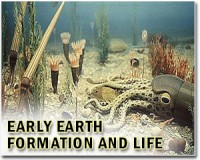| . |  |
. |
Adelaide, Australia (SPX) Feb 02, 2010 A new scientific paper co-authored by a University of Adelaide researcher reports strong evidence that humans, not climate change, caused the demise of Australia's megafauna - giant marsupials, huge reptiles and flightless birds - at least 40,000 years ago. In a paper published today in the international journal Science, two Australian scientists claim that improved dating methods show that humans and megafauna only co-existed for a relatively short time after people inhabited Australia, adding weight to the argument that hunting led to the extinction of large-bodied species. According to Professor Richard `Bert' Roberts from the University of Wollongong and Professor Barry Brook from the University of Adelaide, new methods to directly date bones and teeth of extinct species show that megafauna fossils and Aboriginal tools do not all date from the same period. "Debate about the possible cause of these late Pleistocene extinctions has continued for more than 150 years, with scientists divided over whether climate change or the arrival of humans has been responsible for their demise," Professor Brook says. "Australia was colonised during a time when the climate was relatively benign, supporting the view that people, not climate change, caused the extinctions here," he says. But one site in western NSW - Cuddie Springs - stood out as an anomaly. Fossils of super-sized kangaroos, giant birds and the rhino-sized Diprotodon (the largest marsupial ever to roam Australia) were found in the same sedimentary layers as stone tools, leading some scientists to previously claim "unequivocal evidence" of a long overlap of humans and megafauna. However, Professor Roberts - the lead author of the Science paper "And Then There Were None?" - says direct dating of fossils shows that the artefacts and megafauna fossils at the Cuddie Springs site were mixed together over many thousands of years, long after the giant animals had died. "These results provide no evidence for the late survival of megafauna at this site," Professor Roberts says. "Given that people arrived in Australia between 60,000 and 45,000 years ago, human impact was the likely extinction driver, either through hunting or habitat disturbance," he says. Professor Brook says previous claims for sites containing younger megafauna - such as in Kangaroo Island, eastern Victoria and the highlands of Papua New Guinea - should also be considered suspect in the light of these revised, older dates for the Cuddie Springs fossils.
Share This Article With Planet Earth
Related Links University of Adelaide Explore The Early Earth at TerraDaily.com
 New dinosaur fossil could provide clues to evolution
New dinosaur fossil could provide clues to evolutionWashington (AFP) Jan 28, 2010 US paleontologists said Thursday they have uncovered a new dinosaur species in China's Gobi Desert that could explain how one dinosaur family came to look like birds. The finding extends by 63 million years the fossil record of the Alvarezsauridae family, a group of bird-like dinosaurs with a large claw on their hands and very short, powerful arms. It was the first evidence that this typ ... read more |
|
| The content herein, unless otherwise known to be public domain, are Copyright 1995-2010 - SpaceDaily. AFP and UPI Wire Stories are copyright Agence France-Presse and United Press International. ESA Portal Reports are copyright European Space Agency. All NASA sourced material is public domain. Additional copyrights may apply in whole or part to other bona fide parties. Advertising does not imply endorsement,agreement or approval of any opinions, statements or information provided by SpaceDaily on any Web page published or hosted by SpaceDaily. Privacy Statement |